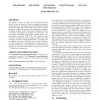EICS
2011
ACM
13 years 3 months ago
2011
ACM
This paper describes a model-based approach for designing distributed user interfaces (DUIs), i.e. graphical user interfaces that are distributed along one or many of the followin...
ACSAC
2010
IEEE
13 years 3 months ago
2010
IEEE
In this work we show that once a single peer-to-peer (P2P) bot is detected in a network, it may be possible to efficiently identify other members of the same botnet in the same ne...
HOTNETS
2010
13 years 6 months ago
2010
Today's Internet services increasingly use IP-based geolocation to specialize the content and service provisioning for each user. However, these systems focus almost exclusiv...
CCR
2010
13 years 9 months ago
2010
In this paper we propose a system that will allow people to communicate their status with friends and family when they find themselves caught up in a large disaster (e.g., sending...
CCR
2010
13 years 9 months ago
2010
OFDMA will be the predominant technology for the air interface of broadband mobile wireless systems for the next decades. In recent years, OFDMA-based networks based on IEEE 802.1...
IMC
2010
ACM
13 years 9 months ago
2010
ACM
Current large-scale topology mapping systems require multiple days to characterize the Internet due to the large amount of probing traffic they incur. The accuracy of maps from ex...
IMC
2010
ACM
13 years 9 months ago
2010
ACM
Operators and researchers want accurate router-level views of the Internet for purposes including troubleshooting and modeling. However, tools such as traceroute return IP address...
TON
2010
13 years 10 months ago
2010
Sensor positioning is a crucial part of many location-dependent applications that utilize wireless sensor networks (WSNs). Current localization approaches can be divided into two ...
CCR
2004
13 years 11 months ago
2004
A team of researchers from the Massachusetts Institute of Technology (MIT) and Northwestern University (NU) is developing a system for long-distance, high-fidelity qubit teleporta...
CCR
2006
13 years 12 months ago
2006
We describe a system in which layer 2 switching is placed directly under the control of layer 3 routing protocols on a hop-by-hop basis. Specifically, ATM switching is controlled ...



